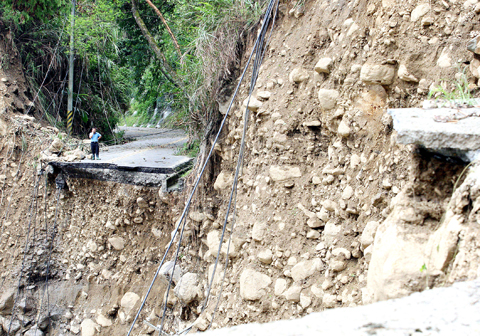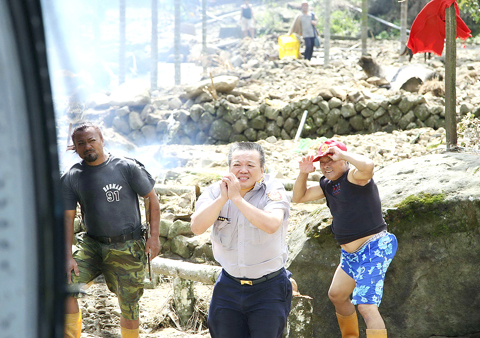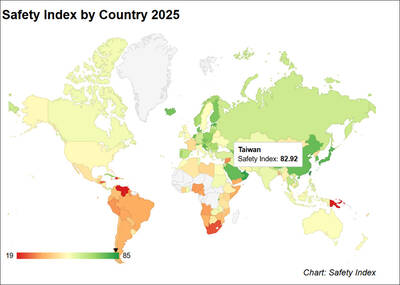Pressure mounted on the government yesterday to speed up operations as patience ran thin among relatives waiting for news of the thousands of residents trapped by mudslides, collapsed bridges or raging rivers in remote mountainous villages — with some feared buried alive — in the aftermath of Typhoon Morakot.
Kaohsiung County Commissioner Yang Chiu-hsing (楊秋興) said yesterday that about 300 people in Xiaolin Village (小林) in Jiasian Township (甲仙) were feared dead.
Xiaolin was one of the areas hardest hit by the flooding and landslides brought by Morakot.

PHOTO: CNA
The village was almost completely flattened by landslides — of 395 houses, only two remain.
Although more than 200 Xiaolin villagers have been rescued in the past two days, Yang said yesterday afternoon that the county government feared the worst.
As the county government compared the number of rescued Xiaolin villagers and those who are confirmed to be alive but are awaiting rescue to the number of people living in Xiaolin, Yang said: “I’d say the number of people unaccounted for was probably somewhere around 300.”

PHOTO: AP
Meanwhile, about 1,000 people in Taoyuan Township (桃源) and 1,500 in Namasiya Township (那瑪夏) are believed to be trapped.
“Everybody is paying attention to Xiaolin Village and Namasiya Township, and nobody cares about the thousands of people trapped in Taoyuan Township. There is a reservoir of water that was caused by a landslide that has dammed a river upstream. I don’t know if it has eroded away yet,” a Taoyuan Township resident said in tears. “I only hope that it will stop raining.”
What the survivor was worrying about did happen — a landslide that had dammed the upstream section of the Laonong River (荖濃溪) eroded away by noon yesterday. Fortunately, downstream villagers fled the area minutes before it burst.
However, the resulting flash flood destroyed a warehouse for explosives used in construction, flushing about 8,000kg of explosives into the Laonong River. While experts said the explosives would not likely cause any immediate danger, authorities warned people who live downstream and rescuers to watch out for the explosives.
Several survivors in Liukuei Township’s Sinfa Village (新發), standing next to a collapsed bridge that connected the community to the outside, signaled for help to rescuers that flew by in helicopters.
A rescue team tried to cross the river, but the raging waters prevented them from doing so — one rescuer almost drowned.
According to the emergency operation center in Chiayi, approximately 10,200 people were still trapped in Alishan (阿里山), Meishan (梅山), Chuchi (竹崎), Jhongpu (中埔) and Fanlu (番路) townships as of 2pm yesterday. A representative told the Taipei Times that the number was calculated based on information from the Household Registration Office.
Despite the fact that most structures have collapsed in Taiho Village (太和) and Meishan Township, a Chiayi Fire Department rescuer said that all villagers — except for four who died — are safe and will soon be rescued.
However, in Fanlu, a man surnamed Ma (馬) said in a news clip broadcast by SET-TV that they were running out of food.
“We only have about one or two days of food supplies,” he said. “A helicopter came a couple of days ago to drop off food and other supplies, but it happened only once.”
A storm survivor who has been stranded for six days in Taitung County’s Jinfong Township (金峰) sent out an e-mail yesterday saying that about 1,000 survivors of a massive mudslide in the mountainous area were on the verge of starvation.
“Even greens and taro roots gathered in the wild have been consumed,” Lin Feng-shu, an elementary school teacher, said in the e-mail.
Lin sent the e-mail yesterday after Taiwan Power Co and Chunghwa Telecom managed to restore Internet services, which were disrupted by Typhoon Morakot after it struck Taiwan last Friday.
“Please help us quickly,” Lin’s message said.
Taitung County Government said that as of yesterday about 16,000 people in Taimali (太麻里), Jinfong, Dawu (大武) and Daren (達仁) townships were cut off from the outside world because of the surging water in the Taimali River (太麻里溪). However, they had received supplies by helicopter, officials said.
Residents there had begun to clean up their homes by hand and on empty stomachs, a staff member of a local government office said.
The military yesterday said it had deployed 4,000 more soldiers to the rescue effort, bringing the total to 38,000, after criticism that the government was too slow in mobilizing rescue efforts. The government said its operations had been hampered because many areas of the country were cut off when roads and bridges collapsed.
Anger at the authorities, however, was apparent among surviving villagers, who said more victims could have been saved if the government had moved sooner and faster.
“How can they be so slow? Clearly they should be sending more helicopters, right?” said Yan Min-rong, 29, as he pored over lists of survivors at a rescue hub in Kaohsiung County’s Cishan Township (旗山).
“It’s too slow,” said Chen Fu-rong, head of a funeral association in Kaohsiung, as she stood alongside the bodies of victims. “They don’t care about the south. They just care about the north.”
President Ma Ying-jeou (馬英九) was confronted by relatives complaining about his government’s handling of the crisis yesterday when he traveled to Yunlin County to inspect relief efforts.
TV footage showed dozens of people surrounding Ma, with one man angrily asking: “What is the government doing? It’s too late, they cannot be saved.”
Since the weather was good for most of yesterday, 113 helicopter flights were able to drop off food, water and other necessities at devastated areas in Liukuei and Namasiya, while 878 more survivors were rescued.
Meanwhile, rescuers yesterday morning confirmed 6,500 people who had been stranded near Alishan (阿里山) and more than 700 in Liukuei. But hundreds of villagers said that many more people could have been buried alive because some villages were either flattened or badly damaged in the typhoon.
While numerous bridges were severely damaged by mudslides and debris washed down the rivers, and many roads were rendered impassable in mountainous regions, the Directorate-General of Highways (DGH) reported that of the 132 damaged and blocked roads, 59 had been reopened.
Vice Minister of Transportation and Communications Yeh Kuan-shi (葉匡時) said the DGH had identified eight key areas that could not be accessed by any road at this time.
“Highways leading to these areas must be opened first so that food, goods and other resources can be delivered to the victims,” he said.
The roads on the list include Highway 18 to Alishan, which was severely damaged by mudslides, making it completely inaccessible until at least Oct. 15.
DGH contractors still cannot cross the section of Highway 21 from Jiaxian to Xiaolin and Namasiya. The contractors are also unable to pass the section of Highway 20 from Liukuei to Laonong (荖濃), Baolai (寶來), Taoyuan and Meishan villages, he said.
The sections of road between Maolin (茂林) and Duonah (多納), between Lidao (利稻) and Meishan on Highway 20, between Sandimen (三地門) and Wutai (霧台) on Highway 24, and between Taimali and Fonggang (楓港) on Highway 9 are also severely eroded. They won’t become accessible until next week.
“The typhoon damage is different from the damage caused by the 921 Earthquake,” Yeh said. “As soon as we clear debris, landslides come to undo our work.”
On Wednesday, two excavators that were on Highway 27 were washed away by the mudslides.
The Taiwan Railway Administration (TRA) said the South Link (南迴鐵路) will not resume full operation for another five months because the Linbienshi Bridge (林邊溪橋) and two other bridges were inundated by water. Currently, trains can operate between Pingtung and Nanchou (南州) as well as between Taitung and Taimali.
As of 10pm yesterday, the death toll from Typhoon Morakot had climbed to 116, with 59 people listed as missing and 45 injured, the Central Emergency Operation Center said.

ENDEAVOR MANTA: The ship is programmed to automatically return to its designated home port and would self-destruct if seized by another party The Endeavor Manta, Taiwan’s first military-specification uncrewed surface vehicle (USV) tailor-made to operate in the Taiwan Strait in a bid to bolster the nation’s asymmetric combat capabilities made its first appearance at Kaohsiung’s Singda Harbor yesterday. Taking inspiration from Ukraine’s navy, which is using USVs to force Russia’s Black Sea fleet to take shelter within its own ports, CSBC Taiwan (台灣國際造船) established a research and development unit on USVs last year, CSBC chairman Huang Cheng-hung (黃正弘) said. With the exception of the satellite guidance system and the outboard motors — which were purchased from foreign companies that were not affiliated with Chinese-funded

PERMIT REVOKED: The influencer at a news conference said the National Immigration Agency was infringing on human rights and persecuting Chinese spouses Chinese influencer “Yaya in Taiwan” (亞亞在台灣) yesterday evening voluntarily left Taiwan, despite saying yesterday morning that she had “no intention” of leaving after her residence permit was revoked over her comments on Taiwan being “unified” with China by military force. The Ministry of the Interior yesterday had said that it could forcibly deport the influencer at midnight, but was considering taking a more flexible approach and beginning procedures this morning. The influencer, whose given name is Liu Zhenya (劉振亞), departed on a 8:45pm flight from Taipei International Airport (Songshan airport) to Fuzhou, China. Liu held a news conference at the airport at 7pm,

Taiwan was ranked the fourth-safest country in the world with a score of 82.9, trailing only Andorra, the United Arab Emirates and Qatar in Numbeo’s Safety Index by Country report. Taiwan’s score improved by 0.1 points compared with last year’s mid-year report, which had Taiwan fourth with a score of 82.8. However, both scores were lower than in last year’s first review, when Taiwan scored 83.3, and are a long way from when Taiwan was named the second-safest country in the world in 2021, scoring 84.8. Taiwan ranked higher than Singapore in ninth with a score of 77.4 and Japan in 10th with

GRIDLOCK: The National Fire Agency’s Special Search and Rescue team is on standby to travel to the countries to help out with the rescue effort A powerful earthquake rocked Myanmar and neighboring Thailand yesterday, killing at least three people in Bangkok and burying dozens when a high-rise building under construction collapsed. Footage shared on social media from Myanmar’s second-largest city showed widespread destruction, raising fears that many were trapped under the rubble or killed. The magnitude 7.7 earthquake, with an epicenter near Mandalay in Myanmar, struck at midday and was followed by a strong magnitude 6.4 aftershock. The extent of death, injury and destruction — especially in Myanmar, which is embroiled in a civil war and where information is tightly controlled at the best of times —